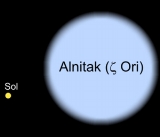
Blue giant
Encyclopedia

Astronomy
Astronomy is a natural science that deals with the study of celestial objects and phenomena that originate outside the atmosphere of Earth...
, a blue giant is a star
Star
A star is a massive, luminous sphere of plasma held together by gravity. At the end of its lifetime, a star can also contain a proportion of degenerate matter. The nearest star to Earth is the Sun, which is the source of most of the energy on Earth...
with a spectral type of O or B (thus being noticeably blue in appearance) and a luminosity
Luminosity
Luminosity is a measurement of brightness.-In photometry and color imaging:In photometry, luminosity is sometimes incorrectly used to refer to luminance, which is the density of luminous intensity in a given direction. The SI unit for luminance is candela per square metre.The luminosity function...
class of III (giant
Giant star
A giant star is a star with substantially larger radius and luminosity than a main sequence star of the same surface temperature. Typically, giant stars have radii between 10 and 100 solar radii and luminosities between 10 and 1,000 times that of the Sun. Stars still more luminous than giants are...
). In the standard Hertzsprung-Russell diagram, blue giants are found in the upper left corner, due to their high luminosity and early spectral type.
A blue giant is a massive star that has exhausted the hydrogen fuel in its core and left the main sequence. Blue giants have a surface temperature of around 30, 000 K and a luminosity some 10, 000 times that of the Sun. As they grow older they expand and cool, eventually becoming red giants, or continuing fusion into a more luminous or massive star.
Blue giants are extremely luminous, reaching absolute magnitude
Absolute magnitude
Absolute magnitude is the measure of a celestial object's intrinsic brightness. it is also the apparent magnitude a star would have if it were 32.6 light years away from Earth...
s of -5, -6 (which is anywhere from 9000 to 25,000 times brighter than our sun) and even higher. Their surface temperature is high enough (20,000 K
Kelvin
The kelvin is a unit of measurement for temperature. It is one of the seven base units in the International System of Units and is assigned the unit symbol K. The Kelvin scale is an absolute, thermodynamic temperature scale using as its null point absolute zero, the temperature at which all...
or more) that a sizable fraction of their energy output is in the ultraviolet range, thus invisible to our eyes.
Most stars of this type are found in O-B association
OB star
OB stars are hot, massive stars of spectral types O or B which form in loosely organized groups called OB associations. They are short lived, and thus don't move very far from where they were formed within their life. During their lifetime, they will emit copious amounts of ultraviolet radiation...
s, large collections of loosely bound young stars. Since they are so hot (but not very dense), their expected life is very short (in the order of tens or hundreds of million years), and current theories predict that most of them will end their lives as supernovae.
Blue giant is a misused term, as giant usually implies an advanced evolutionary state in which the star fuses helium in its core, instead of hydrogen (see red giant
Red giant
A red giant is a luminous giant star of low or intermediate mass in a late phase of stellar evolution. The outer atmosphere is inflated and tenuous, making the radius immense and the surface temperature low, somewhere from 5,000 K and lower...
). There are no "real" blue giants, stable stars of classification OxIII or BxIII; instead, stars such as Bellatrix (B2III) are middle-aged massive stars which are in the process of becoming massive bright giant
Bright giant
The luminosity class II in the Yerkes spectral classification is given to bright giants. These are stars which straddle the boundary between giants and supergiants, and the classification is in general given to giant stars with exceptionally high luminosity, but which are not sufficiently bright...
s (class II), very much unlike red giant stars such as Arcturus (K1III) which represent the final stage of stellar evolution
Stellar evolution
Stellar evolution is the process by which a star undergoes a sequence of radical changes during its lifetime. Depending on the mass of the star, this lifetime ranges from only a few million years to trillions of years .Stellar evolution is not studied by observing the life of a single...
for lower mass stars and are stable as giants. These stars, the massive and middle-aged blue giants, represent a transitory phase where the star is either to become a bright giant (and eventually a planetary nebula and massive white dwarf) or a supergiant
Supergiant
Supergiants are among the most massive stars. They occupy the top region of the Hertzsprung-Russell diagram. In the Yerkes spectral classification, supergiants are class Ia or Ib . They typically have bolometric absolute magnitudes between -5 and -12...
(and eventually a supernova or rare oxygen-neon white dwarf) and no star remains as this kind of blue giant for very long. The equivalent evolutionary stage for a solar mass star would be the subgiant stage (class IV), where hydrogen fusion is slowing and helium fusion is yet to begin.
Other blue giants are merely misclassified hydrogen fusing dwarf stars, such as Spica
Spica
Spica is the brightest star in the constellation Virgo, and the 15th brightest star in the nighttime sky. It is 260 light years distant from Earth...
or the Pleiades
Pleiades (star cluster)
In astronomy, the Pleiades, or Seven Sisters , is an open star cluster containing middle-aged hot B-type stars located in the constellation of Taurus. It is among the nearest star clusters to Earth and is the cluster most obvious to the naked eye in the night sky...
, their exceptional brightness making earlier astronomers believe they were elderly giants and the classification has simply stuck.
Blue giants should not be confused with blue supergiant
Blue supergiant
Blue supergiants are supergiant stars of spectral type O or B.They are extremely hot and bright, with surface temperatures of 30,000-50,000 K. They typically have 10 to 50 solar masses on the Hertzsprung-Russell diagram, and can have radii up to about 25 solar radii...
s such as Rigel
Rigel
Rigel is the brightest star in the constellation Orion and the sixth brightest star in the sky, with visual magnitude 0.18...
or ordinary hydrogen-fusing O to B stars such as Regulus
Regulus
Regulus is the brightest star in the constellation Leo and one of the brightest stars in the night sky, lying approximately 77.5 light years from Earth. Regulus is a multiple star system composed of four stars which are organized into two pairs...
which is a main sequence dwarf star.
See also
- Blue supergiantBlue supergiantBlue supergiants are supergiant stars of spectral type O or B.They are extremely hot and bright, with surface temperatures of 30,000-50,000 K. They typically have 10 to 50 solar masses on the Hertzsprung-Russell diagram, and can have radii up to about 25 solar radii...
- Giant starGiant starA giant star is a star with substantially larger radius and luminosity than a main sequence star of the same surface temperature. Typically, giant stars have radii between 10 and 100 solar radii and luminosities between 10 and 1,000 times that of the Sun. Stars still more luminous than giants are...

